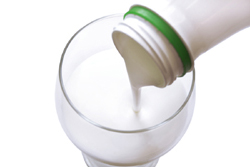Introduction to nutrition and lactose intolerance
- What is lactose intolerance?
- What is the link between calcium and lactose intolerance?
How can people with lactose intolerance make sure they get enough calcium?
- Children, calcium and lactose intolerance
Introduction to nutrition and lactose intolerance
Lactose intolerance is a common condition, causing abdominal pain, bloating and diarrhoea in affected patients. Nutrition in lactose intolerance is important, because many lactose intolerance patients control their symptoms by avoiding foods which contain lactose, especially dairy products. Unfortunately, this may put them at risk of calcium deficiency. Strategies which may help lactose intolerant patients consume adequate calcium in their diet are discussed below.
What is lactose intolerance?
Lactose intolerance is a condition where the gut is unable to break down a type of sugar called ‘lactose‘, commonly found in milk and other dairy products. The problem is due to a lack of the enzyme lactase, which breaks down lactose in the intestines and allows it to be absorbed into the body. Symptoms of lactose intolerance include bloating, abdominal pain or diarrhoea.
Lactose intolerance may be present from birth, develop later in life, or be the result of another gastrointestinal disease such as coeliac disease or inflammatory bowel disease. In most cases it develops with age, and true lactose intolerance is rare in infants and children. There is no specific treatment for lactose intolerance, but people who are affected can often control their symptoms by avoiding foods high in lactose.
What is the link between calcium and lactose intolerance?

The consequences of inadequate calcium intake mainly relate to bone health. Calcium is a major component of bone, helping to strengthen it and prevent fracture. People who do not consume enough calcium are at risk of developing osteoporosis (brittle bones) and of fracture.
How can people with lactose intolerance make sure they get enough calcium?
Dairy products
Many people who are lactose intolerant believe they must avoid all dairy products – but studies have shown that this is not the case. Most lactose intolerant people can tolerate small amounts of dairy products when they are consumed with food or meals. For example, as much as one cup (250ml) of milk, drunk with a meal, did not produce symptoms in one group of lactose intolerant people. In another group, two cups of milk consumed throughout the day and with meals made no difference to symptoms compared to drinking lactose-free milk.
Overall, the studies prove that lactose intolerant patients do not need to completely avoid dairy products to remain symptom-free. The choice of dairy product can also help lactose intolerant people consume calcium. Hard cheese contains only small amounts of lactose compared to cow’s milk. Live-culture yoghurts and other fermented milk products are also lower in lactose, as the healthy bacteria in the yoghurt can partially break down the lactose before consumption.
Lactose-hydrolysed milk and dairy products
Another option for lactose intolerant patients is the use of artificial enzymes to break down the lactose in milk or dairy products. These ‘lactase’ preparations come as either tablets to be taken with food, or as liquids which can be added to milk, which is then refrigerated overnight before consumption. The ‘lactase’ enzyme works to break down the lactose in the milk, leaving it virtually lactose-free the next day. This does leave the milk tasting slightly sweeter than normal milk. A similar process is used to make lactose-free milk, which is available commercially.
Non-dairy sources of calcium
Non-dairy foods high in calcium include some green vegetables such as broccoli, bok choy or pak choy, Chinese cabbage, turnip greens and kale; and canned fish such as sardines or salmon which contain soft bones. In general, the amount of calcium found in these products is lower than in dairy sources of calcium, but they may be options for people who cannot tolerate or dislike dairy products. A number of non-dairy products such as breads, cereals, soy products and orange juice also come ‘fortified’ with calcium – that is, they have calcium added to them during the production process. The amount of calcium that can be absorbed from these foods varies.
Calcium supplements
Calcium supplementation is available in the form of calcium carbonate or calcium citrate. These are tablets which must be swallowed daily, usually with food. Some forms of calcium supplementation can impair the absorption of iron from food, so care must be taken to take supplements with meals low in iron (such as breakfast). Calcium supplementation is not normally recommended for infants and children, because they lack the benefit of other nutrients which would be found in calcium-rich or calcium-supplemented foods. However, for children in whom supplements are needed, liquid calcium gluconate can be used.
Children, calcium and lactose intolerance
Childhood and adolescence is an important time for ensuring adequate calcium consumption. This is because bones are growing and developing during this period, with lots of calcium being laid down for strength. Unfortunately, many children do not consume enough calcium in their diet, and may therefore be at risk of developing osteoporosis or fracture in later life. One reason for low calcium consumption in children may be incorrect beliefs that children cannot tolerate dairy products. In fact, though true lactose intolerance is occasionally present in children from birth, this is a rare condition. Almost all infants and children are able to digest lactose normally, at least until the age of 5 years, and evidence does not support the widespread use of lactose-free formulas and soy milk in young children. This means that most children do not need to avoid dairy products, and should obtain most of their daily calcium from dairy sources.
More information
 |
For more information on dairy products, including information on nutrition for specific age groups and dairy consumption with certain health conditions, as well as some useful tools, videos, recipes and factsheets, see Dairy. |
 |
For more information on nutrition, including information on types and composition of food, nutrition and people, conditions related to nutrition, and diets and recipes, as well as some useful videos and tools, see Nutrition. |
References
- Abrams SA. ‘Calcium requirements in adolescents.’ [online]. UpToDate.com 2006. Available at URL: http://www.uptodate.com (last accessed: 21/10/06)
- Chitkara DK, Montgomery RK, Grand RJ, Buller HA. ‘Lactose intolerance.’ [online]. UpToDate.com 2005. Available at URL: http://www.uptodate.com (last accessed: 21/10/06)
- Demory-Luce D, Motil KJ. ‘Vegetarian diets for children.’ [online]. UpToDate.com 2006. Available at URL: http://www.uptodate.com (last accessed: 21/10/06)
- Goldberg JP, Folta SC, Must A. ‘Milk: can a “good” food be so bad?’ Pediatrics. 2002;110(4):826-832
- Infante, D, Tormo, R. ‘Risk of inadequate bone mineralization in diseases involving long-term suppression of dairy products.’ J Pediatr Gastroenterol Nutr 2000;30:310
- Montalto M et al. ‘Management and treatment of lactose malabsorption,’ World journal of gastroenterology. 2006;12(2):187-91
- Perman JA, Dudley BS. ‘Dairy products: try them-you’ll like them?’ Am J Clin Nutr. 1998 68:995-996.
All content and media on the HealthEngine Blog is created and published online for informational purposes only. It is not intended to be a substitute for professional medical advice and should not be relied on as health or personal advice. Always seek the guidance of your doctor or other qualified health professional with any questions you may have regarding your health or a medical condition. Never disregard the advice of a medical professional, or delay in seeking it because of something you have read on this Website. If you think you may have a medical emergency, call your doctor, go to the nearest hospital emergency department, or call the emergency services immediately.









